
The Glasgow Subway is an underground light metro system in Glasgow, Scotland. Opened on 14 December 1896, it is the third-oldest underground rail transit system in Europe after the London Underground and the Budapest Metro. It is also one of the very few railways in the world with a track running gauge of 4 ft wide. Originally a cable railway, the subway was later electrified, but the double-track circular line was never expanded. The line was originally known as the Glasgow District Subway, and was thus the first mass transit system to be known as a "subway"; it was later renamed Glasgow Subway Railway. In 1936 it was renamed the Glasgow Underground. Despite this rebranding, many Glaswegians continued to refer to the network as "the Subway". In 2003, the name "Subway" was officially readopted by its operator, the Strathclyde Partnership for Transport (SPT).

Strathclyde Partnership for Transport (SPT) is a regional transport partnership for the Strathclyde area of western Scotland. It is responsible for planning and coordinating regional transport, especially the public transport system in the area, including responsibility for operating the Glasgow Subway, the third-oldest in the world.
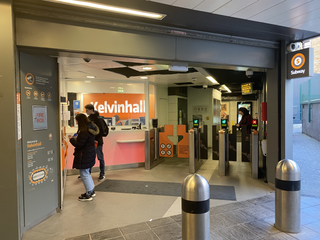
Kelvinhall is an underground station on the Glasgow Subway, renamed after the nearby Kelvin Hall. It is located in the West End of Glasgow, Scotland, near to many of the city's best known tourist destinations including:
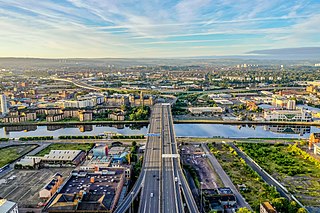
The city of Glasgow, Scotland, has a transport system encompassing air, rail, road and an underground light metro line. Prior to 1962, the city was also served by trams. Commuters travelling into Glasgow from the neighbouring local authorities of North and South Lanarkshire, Renfrewshire, East Renfrewshire, and East and West Dunbartonshire have a major influence on travel patterns, with tens of thousands of residents commuting into the city each day. The most popular mode of transport in the city is the car, used by two-thirds of people for journeys around the city.

Partick is combined National Rail and Glasgow Subway station in the Partick area of Glasgow, Scotland. Along with the adjacent bus station, it forms one of the main transport hubs in Glasgow. As of 2022, it was the fifth-busiest station in Scotland, but was overtaken in 2023. The station is served by Glasgow Subway and ScotRail services and was one of the first to receive bilingual English and Gaelic signs, due to the significant Gaelic-speaking population in the surrounding Partick area.

Jordanhill railway station is a side-platformed suburban railway station in the Jordanhill area in the West End of Glasgow, Scotland. The station, which is governed by Transport Scotland and managed by ScotRail, lies on the Argyle Line and the North Clyde Line. In operation since 1887, the station stemmed losses for an area that was in decline.
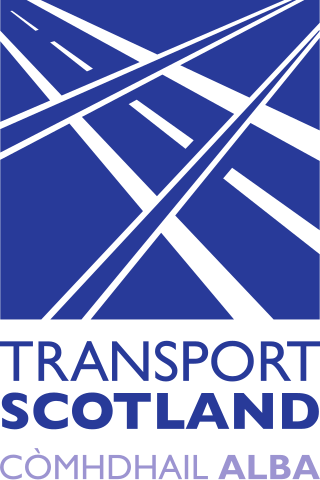
Transport Scotland is the national transport agency of Scotland. It was established by the Transport (Scotland) Act 2005, and began operating on 1 January 2006 as an executive agency of the Scottish Government.

Buchanan Street subway station is a station on the Glasgow Subway in Scotland. It serves the major shopping thoroughfare of Buchanan Street, and is one of two stations on the Subway that directly serve the city centre. Close to Buchanan Bus Station and providing interchange with Glasgow Queen Street railway station via a travelator, it is the busiest station on the Subway, with 2.54 million passengers in the 12 months ending 31 March 2005.
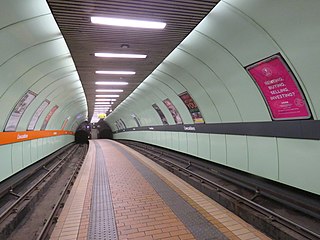
Cowcaddens subway station is a station on the Glasgow Subway and serves the Cowcaddens, Garnethill and Dundasvale areas of Glasgow, Scotland. It is located on the north side of the city centre. Glasgow School of Art, Tenement House, the National Piping Centre, and to some extent Glasgow Caledonian University are local institutions and attractions served by the station.

St George's Cross subway station is a Glasgow Subway station in Glasgow, Scotland which serves the areas of Woodside and Woodlands of the city. It is located at St George's Cross, previously an important road junction but realigned due to the construction of the M8 motorway and less heavily used by traffic since then. Today the station serves mainly the eastern extremity of Great Western Road and the northern reaches of the neighbouring Charing Cross district.

Kelvinbridge subway station is a Glasgow Subway station serving the Woodlands, Woodside and Hillhead areas of Glasgow, Scotland. It is named after the bridge crossing the River Kelvin, next to the station. This station is one of the two serving Kelvingrove Park, the other being Kelvinhall.

Hillhead subway station is a station on the Glasgow Subway, serving the Hillhead area of Glasgow, Scotland, and is the principal station that serves the city's West End. The entrance is located on Byres Road.

Govan subway station is a station serving the area of Govan in Glasgow, Scotland. It is located on the south side of the River Clyde. Just to the south of the station is the main depot and test track for the Glasgow Subway. The station is located near the historic Govan Old Parish Church.
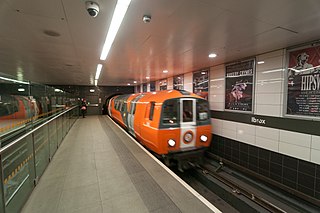
Ibrox subway station is a station serving the Ibrox area of Glasgow, Scotland. The station was known as Copland Road until 1977. The station's surface buildings were replaced during the Subway's modernisation programme, with the main entrance still located on Copland Road. The station now has a side platform arrangement for boarding the trains.

Cessnock subway station is a station on the Glasgow Subway that serves the eastern part of Ibrox and the Cessnock area of the city. It is also the nearest station to Festival Park. Along with Kelvinhall, it is one of only two stations to retain its pre-modernisation surface buildings and entryway. It is also the only station to retain its pre-modernisation livery and signage. The entrance is at the east end of Walmer Crescent and leads under the residential housing.

Kinning Park subway station serves the Kinning Park area of Glasgow, Scotland. However, to reach Kinning Park, a footbridge is provided across the M8.

Shields Road subway station is a station of Glasgow Subway, serving the Pollokshields and Kingston areas of Glasgow, Scotland. Nearby is Charles Rennie Mackintosh's Scotland Street School Museum. This was one of four stations which has Park and Ride facilities.

West Street subway station on the Glasgow Subway network serves the Tradeston and Kingston areas of Glasgow, Scotland.

Bridge Street subway station serves Tradeston, Laurieston and the western fringe of the Gorbals in Glasgow, Scotland. It is the main interchange between the Glasgow Subway and buses travelling to and from the south side. It is the nearest subway station for the Citizens Theatre, O2 Academy Glasgow, Glasgow Sheriff Court Glasgow Central Mosque, as well as the Buchanan Wharf office and residential complex.

The Glasgow Subway rolling stock serves the Glasgow Subway, the third-oldest underground metro system in the world. The Subway is currently on the second generation of rolling stock, with a third-generation which entered service on 11 December 2023. Unlike other Metro systems in the United Kingdom, the Subway has a running gauge of 1,220 mm.

























